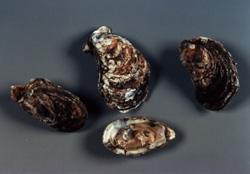Private gardens are one way in which the oyster is making a slow comeback in the
Chesapeake Bay, where natural harvests have fallen to less than one percent of
the catch of a century ago. In Virginia and Maryland, state agencies and volunteers
are building and seeding reefs to provide better habitat for oyster growth, and
researchers are learning from the oysters themselves how and where to foster new
disease-resistant colonies.
|
Once the Bay’s most valuable resource, oysters have fallen on hard times - and so
have the watermen who harvest them. Scientists estimate that a century ago there
were enough oysters to filter the Chesapeake’s entire tidal system in three to four
days. It now takes more than a year for what’s left of the oyster population to filter
the Bay system. The loss of a viable oyster fishery has also placed crushing pressure
on the populations of other commercial seafood, especially blue crabs.
|
The Virginia Institute of Marine Science (VIMS) at Gloucester Point started the
program where the volunteers were growing oysters both on creek bottoms and in
screen trays suspended in the water. In the decade the oyster gardening has been
refined considerably. VIMS has helped households on creeks between the York and
Potomac rivers set up float systems. The gardeners buy certified diseasefree seed
oysters - about the size of your little fingernail. Spawned in late spring, the tiny
oysters are kept in the hatcheries’ closed-tank systems over the summer to isolate
them from diseases. In September, the growers put them into bags made of fine wire
mesh that allow water and phytoplankton to get in, but which have plastic covers to
protect the oysters from crabs and other predators. They hang the bags from their
piers or those of friends.
|
 |
Floats, often one-liter soda bottles, keep the bags just below the water
surface, allowing them to move gently with the wind and tide to keep suspended
sediment from settling on the shells. Come spring, when the oysters will have grown
to the size of a silver dollar, they are transferred to an open float made of wider
mesh in a frame of PVC pipe. Now growth becomes dramatic. (The oysters will be nearly
legal size by the end of August. Half of them will be of harvest size (three inches)
at about 18 months old - half the time it takes wild oysters to grow that big.) The
remaining, smaller oysters will be next year’s crop.
|
|
The oysters’ rapid growth rate produces thin shells, so shuckers must be a little
gentler in opening them. It has not, however, affected their flavor. A few Virginia
growers are now developing commercial markets for their oysters.
|
